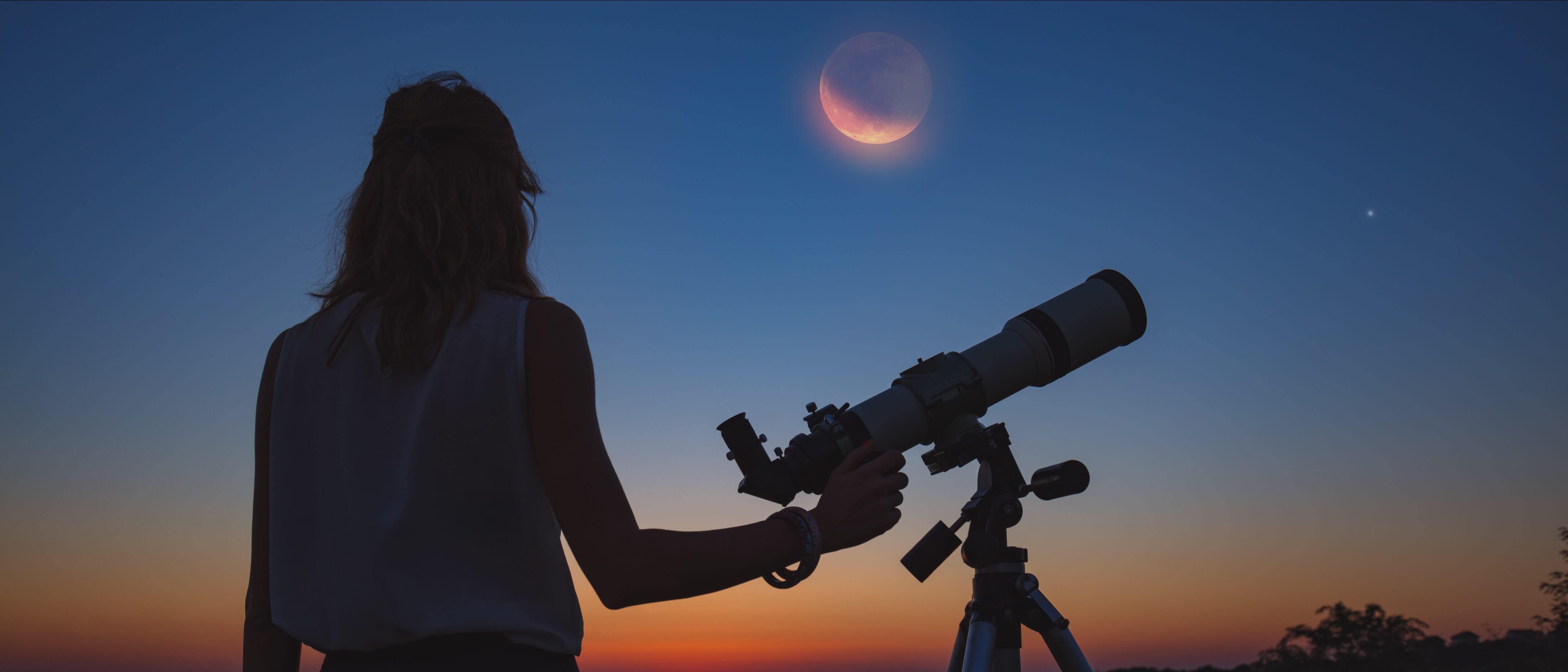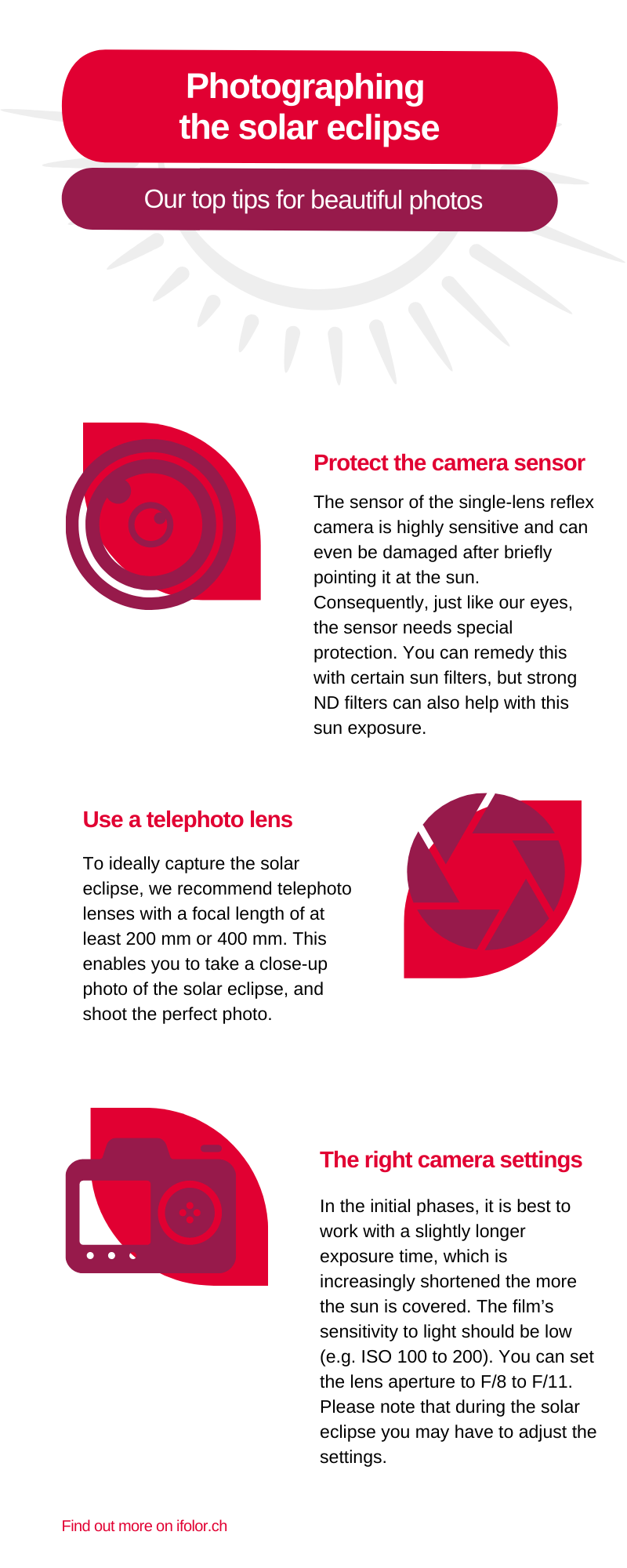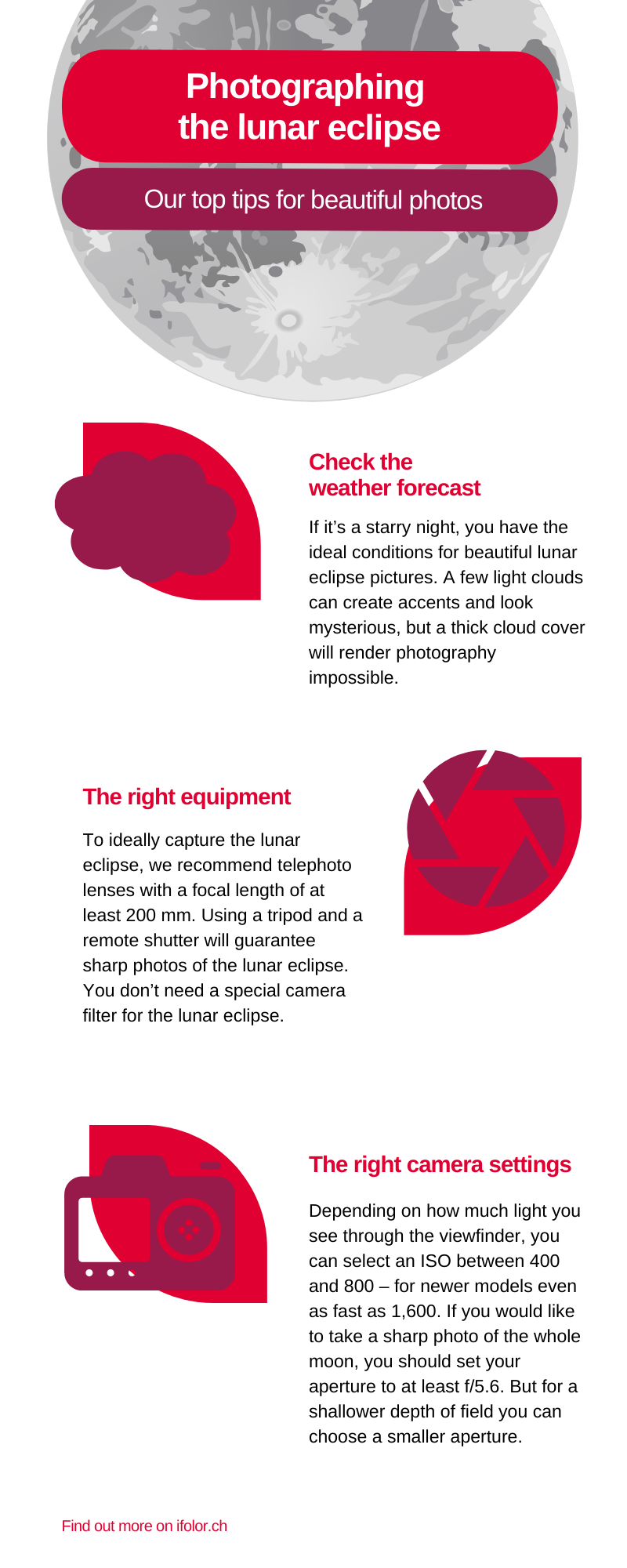
Photographing the solar and lunar eclipses – find out how here!
They are the ultimate natural spectacles: solar and lunar eclipses. For decades, people have been captivated by these. So it’s no wonder that they have always been a popular motif for passionate photographers. However, if you want to get good photos of such an event, make sure you come well prepared. Did you know that this year in Switzerland there will be both a lunar and a solar eclipse? That’s why ifolor has compiled the best photography tips to get great pictures of the solar and lunar eclipses. Let us inspire you!
What happens when there is a solar or a lunar eclipse?
Sun, moon and earth – this cosmic constellation of three celestial bodies causes two very special astronomical events: the solar and the lunar eclipse. A solar eclipse occurs when the sun, earth and moon line up and the moon covers the sun. That said, only every third solar eclipse is a total eclipse. In this case, the sun is completely covered by the moon. Partial solar eclipses, where only part of the sun’s disk is covered, are more common. In a lunar eclipse, the earth is between the sun and the moon. Consequently, the moon is covered by the earth. The sunlight can no longer directly shine on the moon and the moon is thus overshadowed by the earth. There are different phases here, too: Total and partial lunar eclipses in which the moon is either completely or only partly covered. Because of the earth’s atmosphere, in a total eclipse the moon is mostly given a type of “residual lighting” and thus a reddish, orange or brown shimmer. This phenomenon is called a blood moon, which is an absolute highlight, particularly for photographers! Both lunar and solar eclipses are rare natural spectacles. Every year, an average of about two solar eclipses and about two to four lunar eclipses occur. However, they are always only visible from one particular place on earth and not worldwide.
When are the next lunar and solar eclipses occurring in Switzerland?
The Swiss people are lucky because in 2022 there will be both a solar and a lunar eclipse in Central Europe. The next very visible lunar eclipse is a total eclipse, which can be observed on 16 May 2022 in the early hours of the morning. On 25 October 2022, there will be a partial solar eclipse in Central Europe in which – depending on the location – between 15 and 35 percent of the sun will be covered. So, whether you want to photograph a lunar or a solar eclipse: our tips and tricks will properly prepare you to take the perfect photo!
Photographing the solar eclipse: Our top tips for beautiful photos
The first prerequisite for beautiful solar eclipse photos is good weather. If the weather on the day is in your favour, you can start setting up your photography equipment about half an hour ahead of time. If you observe the following tips, your photos are sure to be a roaring success:

Tip #1: Protect the camera sensor
Everyone knows: looking directly at the sun damages the eyes. The same applies to a solar eclipse, so this must be observed when taking photos. As the sensor of the single-lens reflex camera is highly sensitive and can even be damaged after briefly pointing it at the sun, you not only need special glasses to protect your eyesight, but also a solar filter for the lens. You can very easily attach this to your lens and thus prevent the sun rays from getting into your camera. Generally, sun filters are rather expensive, which is why we recommend making your own solar filter. You just need some protective solar film and cardboard. Another inexpensive alternative is strong ND filters from camera stores. Here you should definitely make sure to use a 5.0 filter with a 100,000 filter factor. Weaker or stronger filters either let too much or not enough light through the lens. Also, never look directly through the camera viewfinder – it only takes a few seconds to burn your retina.
Tip #2: Use a telephoto lens
When we think of photos of solar eclipses, we are mostly thinking of photos where the sun is photographed to look as large as possible. A telephoto lens is crucial for this purpose. We recommend a lens with a focal length of at least 200 mm or 400 mm. This enables you to take a close-up photo of the solar eclipse, and the result is a full-frame photo. Although a tripod isn’t compulsory, it can make it much easier for you to photograph the solar eclipse, particularly if you are working with a heavy telephoto lens.
Tip #3: The right camera settings
As the sun is still very bright despite the filter, you can also work with short exposure times when photographing a solar eclipse. In the initial phases, it is best to work with a slightly longer exposure time, which is increasingly shortened the more the sun is covered. As far as the film’s sensitivity to light is concerned, you should always choose an ISO that is as low as possible (e.g. ISO 100 to 200). You can set the lens aperture to F/8 to F/11. Also remember: you may have to adjust the settings during the solar eclipse as the lighting conditions could change within a short time. To take beautiful photographs, it is also recommended to switch your lens from automatic focus to manual focus and take photos with infinity focus. But you can leave the camera on the auto white balance setting. If you select the RAW image format, there’s nothing else standing in the way of your first-class solar eclipse photos.
Photographing the lunar eclipse: How to ensure success
To ensure you capture the perfect lunar eclipse photo, here are a few helpful tips. Ideally, pick a dark observation location with a good view that is far from cities. In addition to the weather, particularly the right equipment and the camera settings play a key role for capturing the perfect lunar eclipse photo:

1. Weather forecast:Is it a starry night? If so, you have the ideal conditions for beautiful lunar eclipse pictures. A few light clouds can create accents and look mysterious, but a thick cloud cover will render photography impossible.
2. Equipment: To photograph a lunar eclipse, you should select a telephoto lens with a focal length of at least 200 mm. A tripod and a remote shutter release will guarantee you sharp photos. You don’t necessarily need a special camera filter for the lunar eclipse.
3. Settings: Depending on how much light you see through the viewfinder, you can select an ISO between 400 and 800 – for newer models even as fast as 1,600. If you would like to take a sharp photo of the whole moon, you should set your aperture to at least f/5.6. But for a shallower depth of field you can choose a smaller aperture. As with the solar eclipse, there isn’t a specific exposure time for this either. Just remember: The less light you see in the sky, the longer the exposure time you can choose.
Beautiful gift idea: Design an eclipse photo album or wall decoration
Whether nature lovers or astronomy fans, with a homemade eclipse photo album or wall decoration, you can quite literally create a unique gift in a flash that your family or friends are sure to love. Simply pick the most beautiful pictures of the solar or lunar eclipse and display your skills in a mini collection. ifolor hopes you have fun with your photography!
